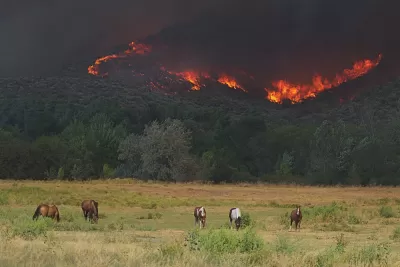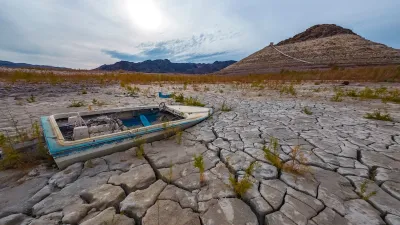Lower-than-average rainfall and reduced snowpacks have led to one of the driest and most dangerous fire seasons in history.

In a piece for the New York Times, Nadja Popovich highlights the "alarming picture" of drought in the American west. "Across the region, reservoir levels are near record lows and mountain snowpack, which slowly releases water in the spring and summer, is largely depleted. In California, water restrictions are already in effect, with more widespread cuts expected. Dry soil conditions are already increasing fire risk."
The extreme conditions facing much of the west this year are unusual in their range and intensity, writes Popovich. "Winter rain and snowfall usually bring most of California’s moisture for the year, but this winter was drier than usual, with warm temperatures arriving early this spring. The state is now in its dry season and is unlikely to see significant rainfall again until October."
Climate scientist Daniel Swain, evaluating this year's low rainfall and early fire season, says "[t]here’s a 100 percent chance that it gets worse before it gets better." A late summer monsoon could help reduce the risk–"if it materializes."
In 2021, "twice as many acres have burned in California as during the same period last year. The state’s fire season has expanded in recent decades, starting earlier and ending later than it used to." States across the west are implementing drought contingency plans in order to mitigate the crisis and conserve precious water resources. According to Dr. Swain, the "predictable elements" that contribute to fire risk, intensified by climate change, are "as bad as [they] can be."
FULL STORY: How Severe Is the Western Drought? See For Yourself.

Alabama: Trump Terminates Settlements for Black Communities Harmed By Raw Sewage
Trump deemed the landmark civil rights agreement “illegal DEI and environmental justice policy.”

Planetizen Federal Action Tracker
A weekly monitor of how Trump’s orders and actions are impacting planners and planning in America.

The 120 Year Old Tiny Home Villages That Sheltered San Francisco’s Earthquake Refugees
More than a century ago, San Francisco mobilized to house thousands of residents displaced by the 1906 earthquake. Could their strategy offer a model for the present?

In Both Crashes and Crime, Public Transportation is Far Safer than Driving
Contrary to popular assumptions, public transportation has far lower crash and crime rates than automobile travel. For safer communities, improve and encourage transit travel.

Report: Zoning Reforms Should Complement Nashville’s Ambitious Transit Plan
Without reform, restrictive zoning codes will limit the impact of the city’s planned transit expansion and could exclude some of the residents who depend on transit the most.

Judge Orders Release of Frozen IRA, IIJA Funding
The decision is a victory for environmental groups who charged that freezing funds for critical infrastructure and disaster response programs caused “real and irreparable harm” to communities.
Urban Design for Planners 1: Software Tools
This six-course series explores essential urban design concepts using open source software and equips planners with the tools they need to participate fully in the urban design process.
Planning for Universal Design
Learn the tools for implementing Universal Design in planning regulations.
Clanton & Associates, Inc.
Jessamine County Fiscal Court
Institute for Housing and Urban Development Studies (IHS)
City of Grandview
Harvard GSD Executive Education
Toledo-Lucas County Plan Commissions
Salt Lake City
NYU Wagner Graduate School of Public Service





























